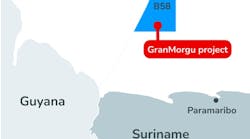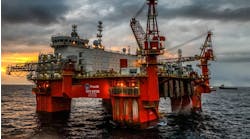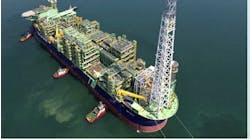Shell successfully deploys system
William FurlowOne of Shell's deepwater drilling superintendents, looking for a way to cut costs and move 4th generations semisubmersibles to deeper water, helped develop a new mooring system for deepwater. Bill von Eberstein said he wanted to move these rigs out past 5,000 ft of water without the high cost of a dynamic positioning system or the instability of a cantinary mooring system.
Technology Editor
Past 5,000 ft water depths, a traditional catenary mooring system becomes impractical for a 4th generation semisubmersible. The system itself is bulky, heavy, and requires special anchorhandling vessels. In addition, it is difficult for these rigs to stay on station in such deep water with a conventional catenary system.
There is so much slack in the mooring lines that the rig moves quite a bit with the wind, waves, and current. It is also difficult to control the rig movements on the mooring system. If the operator adjusts the location of the rig using the mooring lines, there is quite a bit of lag time, making it difficult to judge when the rig had been moved sufficiently. A catenary system of this size also puts a strain on the winches of the vessel and adds to the variable weight.
Taut leg systems
Taut leg mooring systems cut down on the amount of wire rope being used, but add quite a bit of vertical load to the rig. Drag anchors rely on long, slack chain to minimize vertical load. Suction anchor systems had been used successfully in the North Sea, and were actually invented by Royal Dutch Shell years ago.But the seabed of the US Gulf of Mexico, where von Eberstein was interested in operating this system, is made up of much softer clays and silt. Also, von Eberstein was interested in a suction pile system that could be removed as easily as it is installed, for shorter duration drilling programs.
To design the suction caisson systems Shell turned to Aker Maritime. The idea was to come up with a semi-taut system that could not only hold a 4th generation semisubmersible on station in upto 7,000 ft of water. Delmar Systems initiated the idea of installing and retrieving the system using one anchor-handling boat and a remotely operated vehicle (ROV). The ROV was not only used for hooking up and releasing the anchor from the lowering cable, but installing it by pumping out the air in the anchor, and retrieving it by pumping the air back into the top of the anchor.
Although Aker participated in the engineering and testing of this equipment in 1996, the company went another direction with its own anchor design.
Delmar systems designed and built the suction anchor system used by Shell. The limitations on deepwater mooring for a vessel are primarily environmental loads on the rig. Wind, water, waves, currents, and storm conditions all play a role in stressing the vessel's capabilities.
At the same time, there are a number of limitations imposed by dynamic positioning (DP) systems. These DP systems are expensive to install during conversions and costly to operate. In a multi-well development a rig may need to be on station for the better part of a year. From the standpoint of fuel consumption alone, a DP system can burn 32,000 gal/day.
Installation, hookup
The Shell Delmar system was installed in just under 30 days using an anchor handling boat and ROV. Billy Bergeron, Senior Mooring Analyst with Delmar Systems, said other proposed methods of installing suction anchors include the use of derrick barges, large constructor class vessels or two-boat deployment scenarios. These methods all require additional crew and higher vessel costs. In the two-boat scenario one aspect often overlooked is the inability to relax torque build up in the wire creating increased hazard while working and compromising the life of the wire.The 30 days installation window for this job included mobilization time, installation of the piles and the pumping of seawater that sinks them into place. The mooring system was hooked up to the rig in less than a day's time and so far the rig movement has been as expected. In 5,400 ft of water the rig has moved no more than 100 ft off of station. With the taught leg system it is much easier to winch the rig onto station because there is so much less slack in the mooring lines.
The deployment and retrieval of the suction anchors has been refined to use one vessel equipped with an ROV, made possible with Delmar's subsea connector, Bergeron said. The vessel of choice is loaded with up to four suction anchors per trip. Once on location the overboard process begins by situating the suction anchor over the stern roller, allowing the winch to slowly lower it. When the suction anchor reaches a point under the vessel out of the splash zone, the female portion of the Delmar subsea connector is deployed and connects to the center of the caisson. This is necessary to ensure verticality for embedment. The suction anchor is then ready to be lowered to the sea floor. At the point of embedment the ROV attaches itself to orientate and begin pumping procedures. This particular installation required the mooring pad-eye be within five degrees of orientation. When the suction anchor has successfully been self-embedded under its own weight forming a seal between the soil and caisson tip, the flooding valves are closed and water evacuation begins. Using the ROV's pump, water is removed from the caisson. This creates a pressure differential in the caisson and the hydrostatic pressure forces the caisson into the sea floor. The soils surrounding the fully penetrated suction anchor start to consolidate shortly thereafter.
Copyright 1999 Oil & Gas Journal. All Rights Reserved.


